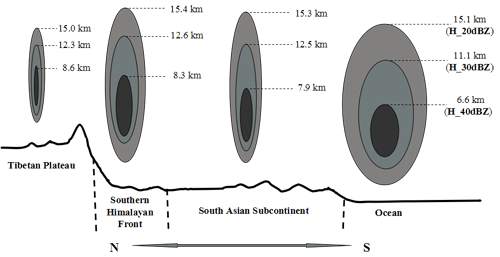IAP scientists revealed a comprehensive pattern of deep convective systems over the Tibetan Plateau
Date:2014-09-05
Deep convective systems are vital in stratosphere–troposphere exchange and play an important role in global energy exchange and the hydrological cycle. The Tibetan Plateau (TP) exerts a crucial impact on the formation and enhancement of deep convection nearby.
QIE Xiushu and her team from Institute of Atmospheric Physics, examined deep convective systems (DCSs, with 20-dBZ echo tops exceeding 14 km) and intense DCSs (IDCSs, with 40-dBZ echo tops exceeding 10 km) over four adjacent unique regions, including the TP, the southern Himalayan Front (SHF), the South Asian Subcontinent (SAS) and the ocean. DCSs and IDCSs are the most frequent over the SHF, where the intensity, in terms of strong radar echo (namely 40-dBZ) top height, ice-particle content and lightning flash rate, is the strongest. DCSs over the TP are relatively weak in convective intensity and small in size, but occur frequently. Oceanic DCSs possess the tallest cloud top (mainly reflects small ice particles), but their convective intensity is markedly weaker (Fig. 1). Different with the convective intensity of DCS, the cloud top height, based on the infrared TBB, increases southward from the TP to the SHF, SAS, and ocean. Although most of both DCSs and IDCSs occur between April and October, DCSs have a peak in August, while IDCSs have a peak in May.
Citation: Xiushu Qie*, Xueke Wu*, Tie Yuan, Jianchun Bian, and Daren Lu, 2014: Comprehensive Pattern of Deep Convective Systems over the Tibetan Plateau–South Asian Monsoon Region Based on TRMM Data. J. Climate, 27, 6612–6626. doi: http://dx.doi.org/10.1175/JCLI-D-14-00076.1
Funded by: the National Key Basic Research and Development (973) Program of China (2010CB428601) and the National Natural Science Foundation of China
(40930949 and 40905008).

Figure 1. Climatological structural features of DCS over four different subregions based on the TRMM PR. The size of ellipses reflects schematically the mean 20, 30 and 40 dBZ echo top height and size of the DCS. The size is deduced from the radar pixel count for reflectivity exceeding 20, 30 and 40 dBZ, respectively.
